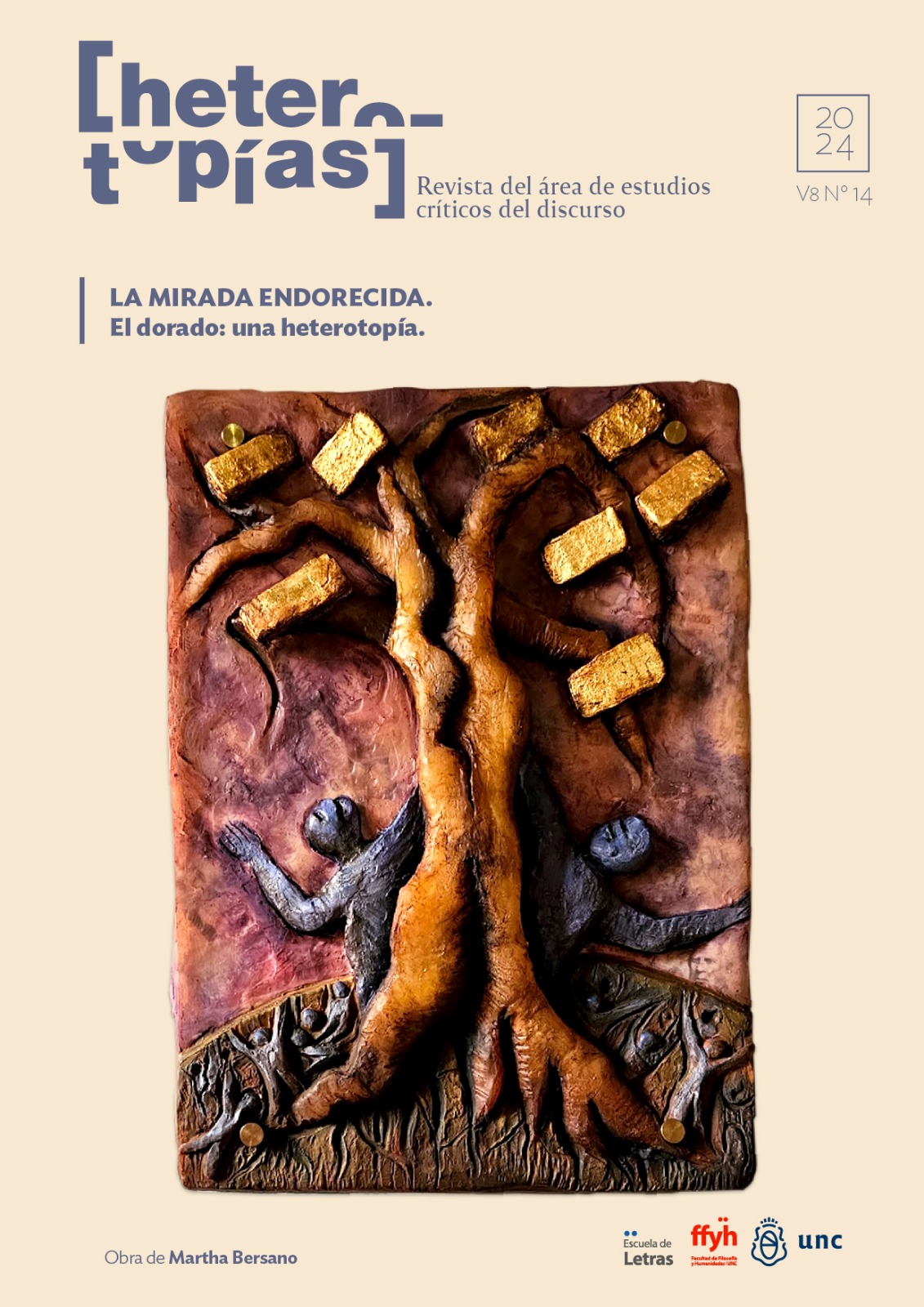La mirada endorecida: El dorado, una heterotopía Aurofictions
Main Article Content
Abstract
El dorado permeates the borders between fiction, myth, imagination and history and encompasses multiple modes of existence that turn our gazes golden. Dazzled by the enjoyment of reflections, they project (and return) forms of value and greed that feed the blind belief in infinite accumulation and extractivism, without considering the ways of life or the possibility of counting the inhabitants that make up each golden heterotopia and feel their existence affected. Marín and Méndez invite us to think about what is El Dorado? How many El Dorados exist and existed in different geographical coordinates, but with similar ways of life? We know that El dorado functions as a colonial operative, but how many times have we stopped to think about the materiality and the agents involved in this history and in its perception? what does desire do in the acting potentialities of El dorado, what does gold, its brightness, the golden, the reflections, the sun, what does courage do, what do the dead do (ecocides, terricides, epistemicides, genocides)? How do the blood in the earth, the interrupted inheritances, the mineral offerings to the gods, what does the language do, what does the malinche do, how do these agents (among many others) participate in the territorial continuity of El dorado? These issues, among others, accompany the various articles that make up the dossier.
Downloads
Article Details

This work is licensed under a Creative Commons Attribution-NonCommercial-ShareAlike 4.0 International License.
Those authors who have publications with this journal, accept the following terms: Those authors who have publications with this journal, accept the following terms:
a. The authors will keep their copyright and guarantee to the journal the right of first publication of their work, which will be simultaneously subject to the Creative Commons Attribution - Non-Commercial - Share Alike (by-nc-sa) Attribution License; no commercial use of the original work or any derivative works is allowed, the distribution of which must be done with a license equal to the one that regulates the original work.
b. Authors may adopt other non-exclusive license agreements for the distribution of the published version of the work (e.g., deposit it in an institutional telematic archive or publish it in a monographic volume) provided that the initial publication in this journal is indicated.
c. Authors are allowed and recommended to disseminate their work through the Internet (e.g. in institutional telematic archives or on their website) before and during the submission process, which may lead to interesting exchanges and increase the number of citations of the published work. (See The effect of open access).
How to Cite
References
Benchimol, P (2020) Estructura del sistema monetario internacional: repensando la dinámica actual a partir de sus transformaciones históricas. Revista enfoques, Volumen XXXII, Nº 2, Pp. 25-49.
Bellacasa, M. P. (2023) El espíritu del suelo. Por una comunidad más que humana. Tercero incluido, Barcelona.
Capitán Vallvey (2017). Químicos y alquimistas. En: Entre la alquimia y la química. Editorial universitaria de Granada Pp. 15-53.
Cohen, J. (2015) Stone: an ecology of the inhuman. Universidad de Minnesota. EUA.
Defert, D. (2010) ‘Heterotopía”: Tribulaciones de un concepto entre Venecia, Berlín y Los Ángeles. En: Foucault, M. (2010) El cuerpo utópico. Las heterotopías. Nueva visión. Argentina.
Foucault, M. (2010) El cuerpo utópico. Las heterotopías. Nueva visión. Argentina.
Foucault, M. (2008) Las palabras y las cosas. Una arqueología de las ciencias humanas. S XXI. Argentina.
Haraway, D. (2017) Testigomodesto@segundo_milenio. Hombrehembra_ conooce_oncorata. Feminismo y Tecnociencia. Rara Avis.
Parikka, J. (2021) Una geología de los medios. Caja negra. CABA.
Parikka, J. (2021) Antropobsceno y otros ensayos. Medios, materialidad y ecología. Mímesis.
Santos, S. (2006) Historia de la alquimia I; La alquimia griega. Real Sociedad Espanola de Química, N 102 (2) Pp. 60-67.
Segemar. (2004) Historia de la Minería Argentina Tomo I y II.
Svampa, M.; Viale, E (2014). Maldesarrollo: La Argentina del extractivismo y el despojo. Buenos Aires: Katz.
Disponible en: https://www.memoria.fahce.unlp.edu.ar/libros/pm.1260/pm.1260.pdf
Szendi, P. (2021) Posfacio. El anverso y reverso de los medios. En: Parikka, J. (2021) Antropobsceno y otros ensayos. Medios, materialidad y ecología. Mímesis. Pp. 157-163.
Todorov, T. (2007) La conquista de América. El problema del otro. SXXI eds.
Villalobos Ruminot, S. 2016. Heterografías de la violencia. Historia, nihilismo, destrucción. La cebra.
